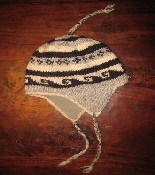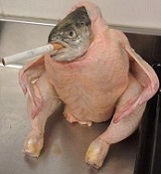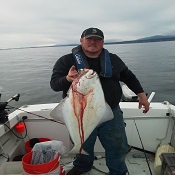#875821 - 12/18/13 12:02 PM
 Re: Please Enlighten me.
[Re: FleaFlickr02]
Re: Please Enlighten me.
[Re: FleaFlickr02]
|

River Nutrients

Registered: 03/08/99
Posts: 13445
|
Met'lheadMatt,
That's the point. Harvest managers believe they aren't settling for the bottom of the barrel. They're managing for maximum harvest, not maximum run size, or maximum escapement, or maximum recreation. The largest number of dead fish, year in and year out, that's their management goal. And it's now vested in the federal court system in WA state waters where treaty tribes fish. And by their yardstick, management is very successful, except for pink salmon runs, where the runs have become more numerous than what the commercial fish buyers will purchase. = Management failure, because of so many salmon that weren't harvested.
Sg
|
|
Top
|
|
|
|
#875864 - 12/18/13 03:25 PM
 Re: Please Enlighten me.
[Re: Swifty27]
Re: Please Enlighten me.
[Re: Swifty27]
|

Three Time Spawner
Registered: 12/29/99
Posts: 1604
Loc: Vancouver, Washington
|
Swift - So where would the unclipped parent come from?
From the wild stock, obviously. Which means fishery managers would be "mining" the wild stock to supplement the hatchery stock. Could be fine if the wild stock is healthy, is spawning successfully, and may have "excess" adults. But if not, the practice of mining the wild fish just to prop up the hatchery is a major reason some wild stocks are no longer with us, particularly on the OP. That practice becomes part of the problem, not the cure.
|
|
Top
|
|
|
|
#875868 - 12/18/13 03:48 PM
 Re: Please Enlighten me.
[Re: Fishyfeller]
Re: Please Enlighten me.
[Re: Fishyfeller]
|

Hippie

Registered: 01/31/02
Posts: 4450
Loc: B'ham
|
If a fish is made in a hatchery is it no longer a wild fish even if both parents were wild?
Correct, by definition. There is an ever-increasing amount of knowledge on the topic but "discussions" get ugly in a hurry, largely because the average fisherman doesn't know or care to know anything more than how to find the fish in the river and bring it home. Plus, any reading on the topic tends to be both dry and depressing. http://www.ncbi.nlm.nih.gov/pmc/articles/PMC3352433/ Abstract: Accumulating data indicate that hatchery fish have lower fitness in natural environments than wild fish. This fitness decline can occur very quickly, sometimes following only one or two generations of captive rearing. In this review, we summarize existing data on the fitness of hatchery fish in the wild, and we investigate the conditions under which rapid fitness declines can occur. The summary of studies to date suggests: nonlocal hatchery stocks consistently reproduce very poorly in the wild; hatchery stocks that use wild, local fish for captive propagation generally perform better than nonlocal stocks, but often worse than wild fish.
|
|
Top
|
|
|
|
#875871 - 12/18/13 04:02 PM
 Re: Please Enlighten me.
[Re: AP a.k.a. Kaiser D]
Re: Please Enlighten me.
[Re: AP a.k.a. Kaiser D]
|

Spawner
Registered: 03/21/06
Posts: 684
|
If 55 wild fish where used to cross with 55 F1 fish, you would essentially be taking 55 fish from future return on average. But the impact of out of basin stock co-mingling would become null and void. And on any of the coastal stream. I catch clipped fish all the way til closure, and many clipped kelts. So they are co-mingling. I agree we would be losing 55 fish, but that may be minimal, to the losses of out of basin stock co-mingling. A loss that would strengthen the wild component, compared to the current plan
|
|
Top
|
|
|
|
#875881 - 12/18/13 04:49 PM
 Re: Please Enlighten me.
[Re: Fishyfeller]
Re: Please Enlighten me.
[Re: Fishyfeller]
|

River Nutrients

Registered: 10/28/09
Posts: 3339
|
I'm only posting this because I took the time to write it. A.P.'s post above links to what is undoubtedly a better scientific summation. With that...
Fishyfeller/Swifty27:
Remember that all hatchery fish initially came from wild parents. When those parents are not native to the river for which they are bred, a different range of issues exists, but ignore that for now. While the first hatchery broods probably had high levels of fitness and productivity, rearing in a hatchery environment does little to select for the most fit specimens (no predation, consistent water conditions, and plenty of food to go around), so a lot of less fit specimens survive to smolt and be released than would survive being reared in the wild environment. Furthermore, there is no competition for spawning among returning adult hatchery fish, so the gene pool ends up with increasing representation by the less fit recruits with each generation. As natural selection has less and less influence on a given stock, that stock becomes less and less fit to survive in the wild environment.
If it's true that hatcheries are better at producing numbers of returning fish (in many cases it's not), it's because so many more hatchery smolt are released than wild stock survive to smolt. In terms of returning adults per smolt migrating out, the wild smolt outperform their hatchery counterparts significantly.
It's a tough nut to crack. When all the costs of producing hatchery fish are considered, hatcheries are probably among the least cost effective expenditures our governments undertake. The trouble is that salmon are an important commercial food source, and while I'm confident wild stocks could recover to a level that would support solid recreational opportunities on their own, the same can't be said for the commercial market. That's the real reason we need hatcheries. Because commercial harvest takes such a big chunk of the wild returns and the hatchery returns, our sport fishing opportunities are also dependent on hatchery "supplementation," if they're to be meaningful anyway.
|
|
Top
|
|
|
|
#875896 - 12/18/13 05:34 PM
 Re: Please Enlighten me.
[Re: Fishyfeller]
Re: Please Enlighten me.
[Re: Fishyfeller]
|

Spawner

Registered: 12/14/01
Posts: 640
Loc: The Tailout
|
wouldn't it be beneficial to rear wild fish in hatcherys ? That's impossible. Wild fish are wild. Once they are put in hatcheries, they are hatchery fish and the genetics that they will propagate are the genetics that benefit them in the hatchery environment. ie the offspring they produce survive better if they have genes that benefit the hatchery life, not life in the wild. When people learn the biology of this stuff, It all boils down to 2 camps: 1) The people that want to recover the wild fish 2) The people that want to pump the rivers full of hatchery fish That there is a happy medium is probably a fantasy, though we are constantly trying it seems. The latest effort appears to be setting aside certain rivers as gene banks and planting others. I think it might work better than what we have now, but it's certainly not perfect.
_________________________
If every fisherman would pick up one piece of trash, we'd have cleaner rivers and more access.
|
|
Top
|
|
|
|
#875898 - 12/18/13 05:39 PM
 Re: Please Enlighten me.
[Re: FleaFlickr02]
Re: Please Enlighten me.
[Re: FleaFlickr02]
|

Returning Adult

Registered: 08/21/13
Posts: 372
Loc: Tri-Cities, WA
|
Coho and Flickr. Totally agree with you both. I was just trying to briefly answer the question on rearing native offspring in hatcheries. Not trying to argue right, wrong, or otherwise. There's no easy answer. There's nuances to each species and each hatchery. I only know some details of what is done up here on the Columbia/Snake systems. Even then, I don't know as much as I would like to. There's a reason there's thousands of pages on the subject. For anyone with some interest in a 50,000 document on the Columbia/Snake Basin Hatcheries, US v Oregon is pretty interesting. Page 111-113 shows steelhead production for harvest, supplementation, and broodstock. http://www.fws.gov/pacific/fisheries/hat...Mngmt_Agrmt.pdf
|
|
Top
|
|
|
|
#875922 - 12/18/13 07:12 PM
 Re: Please Enlighten me.
[Re: Wild Chrome]
Re: Please Enlighten me.
[Re: Wild Chrome]
|

Three Time Spawner
Registered: 12/29/99
Posts: 1604
Loc: Vancouver, Washington
|
WC - I'm not sure it's that simple, but I'll play along....
The ESA requires Option #1. That is, restoration of WILD fish is the goal.
However, the prescence of many dams on the Columbia Rv and elsewhere make option #1 almost impossible. That is, restoration of wild salmon maybe unattainable, as a goal. As such, option #2 is the stark reality if we want salmon in our watersheds in high enough numbers to allow harvest (which is a Treaty-reserved right by for the Tribes).
So, how can we achieve #1 in light of the realities of #2?
Recall, that if option #1 is found to be unattainable, the ESA requires either an exemption thru the God Squad, or Congressional authorization to make the necessary infrastructure adjustments to allow it to be successful (in other words, dam removal).
|
|
Top
|
|
|
|
#875964 - 12/18/13 10:14 PM
 Re: Please Enlighten me.
[Re: Wild Chrome]
Re: Please Enlighten me.
[Re: Wild Chrome]
|

Juvenile at Sea

Registered: 06/22/13
Posts: 185
Loc: Port Angeles, Wa
|
wouldn't it be beneficial to rear wild fish in hatcherys ? That's impossible. Wild fish are wild. Once they are put in hatcheries, they are hatchery fish and the genetics that they will propagate are the genetics that benefit them in the hatchery environment. ie the offspring they produce survive better if they have genes that benefit the hatchery life, not life in the wild. When people learn the biology of this stuff, It all boils down to 2 camps: 1) The people that want to recover the wild fish 2) The people that want to pump the rivers full of hatchery fish That there is a happy medium is probably a fantasy, though we are constantly trying it seems. The latest effort appears to be setting aside certain rivers as gene banks and planting others. I think it might work better than what we have now, but it's certainly not perfect. So you are saying even when both parents are wild the young are no longer have wild DNA. I kinda find that statement to be absurd. So if a Chinese couple move to Italy and have children they will produce children with Italian DNA. Just because it was born in a hatchery doesn't ruin the DNA. (granted natural selection is less of a factor in hatcheries) So I guess the basic equation is can a hatchery take wild pairs and create more surviving young then can be produced in nature. If the answer is no we may as well stop kidding ourselves and wild salmon WILL go extinct. Maintaining the same numbers and never seeming to increase populations sounds like a failure equation. I guess the solution to not having hatcheries is to have 0 harvest by anyone. No catch and release , no sportsmen, no commercial, no tribes.
|
|
Top
|
|
|
|
#875989 - 12/18/13 11:15 PM
 Re: Please Enlighten me.
[Re: Fishyfeller]
Re: Please Enlighten me.
[Re: Fishyfeller]
|

Returning Adult

Registered: 08/21/13
Posts: 372
Loc: Tri-Cities, WA
|
So you are saying even when both parents are wild the young are no longer have wild DNA. I kinda find that statement to be absurd. So if a Chinese couple move to Italy and have children they will produce children with Italian DNA. Just because it was born in a hatchery doesn't ruin the DNA. (granted natural selection is less of a factor in hatcheries)
I would say that the children still have Chinese genes, but are less fit to be thrown back into China after their adolescence and survive. Tough analogy between humans and fish due to the rearing aspect.
Edited by Swifty27 (12/18/13 11:15 PM)
|
|
Top
|
|
|
|
#875990 - 12/18/13 11:15 PM
 Re: Please Enlighten me.
[Re: ]
Re: Please Enlighten me.
[Re: ]
|

Spawner
Registered: 03/21/06
Posts: 684
|
The smolt from two wild parents are F1's, First Generation, once removed from their Native environment. If let to reproduce on their own, they have an 85% fitness! but their smolt hatched in the native environment! return to full fitness. The problem lies in hatchability, the pair of wilds, on average can be expected only to produce two returning fish. But in captivity the number could return 2-4% or 20-40 returning adults, the key would be to release early before imprinting, so they return to their native environment, even with an 85% fitness you could expect to return not the average two as the wild counter parts! but an average of 1.70. But that would be multiplied by the 20-40 returning adults from the original F1 pair.
|
|
Top
|
|
|
|
#875992 - 12/18/13 11:20 PM
 Re: Please Enlighten me.
[Re: Met'lheadMatt]
Re: Please Enlighten me.
[Re: Met'lheadMatt]
|

Spawner
Registered: 03/21/06
Posts: 684
|
Now I do understand Salmo's statement, and the surplus would be selected for harvest, so nothing gained, except if we Broodstock we lesson the damage of co-mingling with rats. I understand we lose some wilds in the process, but how many are lost in co-mingling and stock degradation
|
|
Top
|
|
|
|
#875994 - 12/18/13 11:28 PM
 Re: Please Enlighten me.
[Re: Met'lheadMatt]
Re: Please Enlighten me.
[Re: Met'lheadMatt]
|

Spawner
Registered: 03/21/06
Posts: 684
|
What is natural selection, they are all horned out like dogs, I have seen many a big bucks with dink little clipped and I clipped hens
|
|
Top
|
|
|
|
#875999 - 12/18/13 11:47 PM
 Re: Please Enlighten me.
[Re: Fishyfeller]
Re: Please Enlighten me.
[Re: Fishyfeller]
|

Spawner

Registered: 12/14/01
Posts: 640
Loc: The Tailout
|
So you are saying even when both parents are wild the young are no longer have wild DNA. I kinda find that statement to be absurd. So if a Chinese couple move to Italy and have children they will produce children with Italian DNA. Just because it was born in a hatchery doesn't ruin the DNA. (granted natural selection is less of a factor in hatcheries)
Evolution is constant. Their DNA will be 100 % wild, but they are no longer living in the wild, therefore the wild fish DNA no longer gives them the evolutionary advantages they had. They now have to survive in whatever fashion they are forced to by the hatchery operations. Therefore, starting with the first generation in the hatchery, genes that benefit hatchery fish will be promoted among surviving offspring. That there is an initial boost in the number of (wild Brood) hatchery offspring, yes, but each subsequent generation is less genetically fit in the wild. You should read this article: http://oregonstate.edu/ua/ncs/archives/2...ild-salmon-runs" The underlying problem, experts say, is Darwinian natural selection.
Fish that do well in the safe, quiet world of the hatcheries are selected to be different than those that do well in a much more hostile and predatory real-world environment. Using wild fish as brood stock each year should lessen the problem, but it was just that type of hatchery fish that were used in the Hood River study. This demonstrates that even a single generation of hatchery culture can still have strong effects. "
_________________________
If every fisherman would pick up one piece of trash, we'd have cleaner rivers and more access.
|
|
Top
|
|
|
|
#876010 - 12/19/13 12:18 AM
 Re: Please Enlighten me.
[Re: Wild Chrome]
Re: Please Enlighten me.
[Re: Wild Chrome]
|

Spawner
Registered: 03/21/06
Posts: 684
|
The problem with current hatchery practices is we leave them confined to long, wait for the imprint timeframe before release, let them go early and imprint to the system. We had real great results with very early release, on the Satsop, the creel surveys months later showed very healthy, and size compared to the wild counter part, these where released two weeks after clipping. Little guys. I gave 3-400 hours annually to the program, and seen the results, and see them now, And I miss it. We mated the biggest to biggest and returned very nice fish, one tipped the scales at 33lbs and it was clipped, but the scale samples and dorsel fin suggested it was an early release, it those days we where also returning a strong wild component. We never bred out of F1's, but took them to the upper reaches of the tribes in the system and released them, this helped with those numbers
|
|
Top
|
|
|
|
|
|
0 registered (),
781
Guests and
1
Spider online. |
|
Key:
Admin,
Global Mod,
Mod
|
|
11499 Members
17 Forums
72912 Topics
824682 Posts
Max Online: 3937 @ 07/19/24 03:28 AM
|
|
|














 Previous Topic
Previous Topic Index
Index

